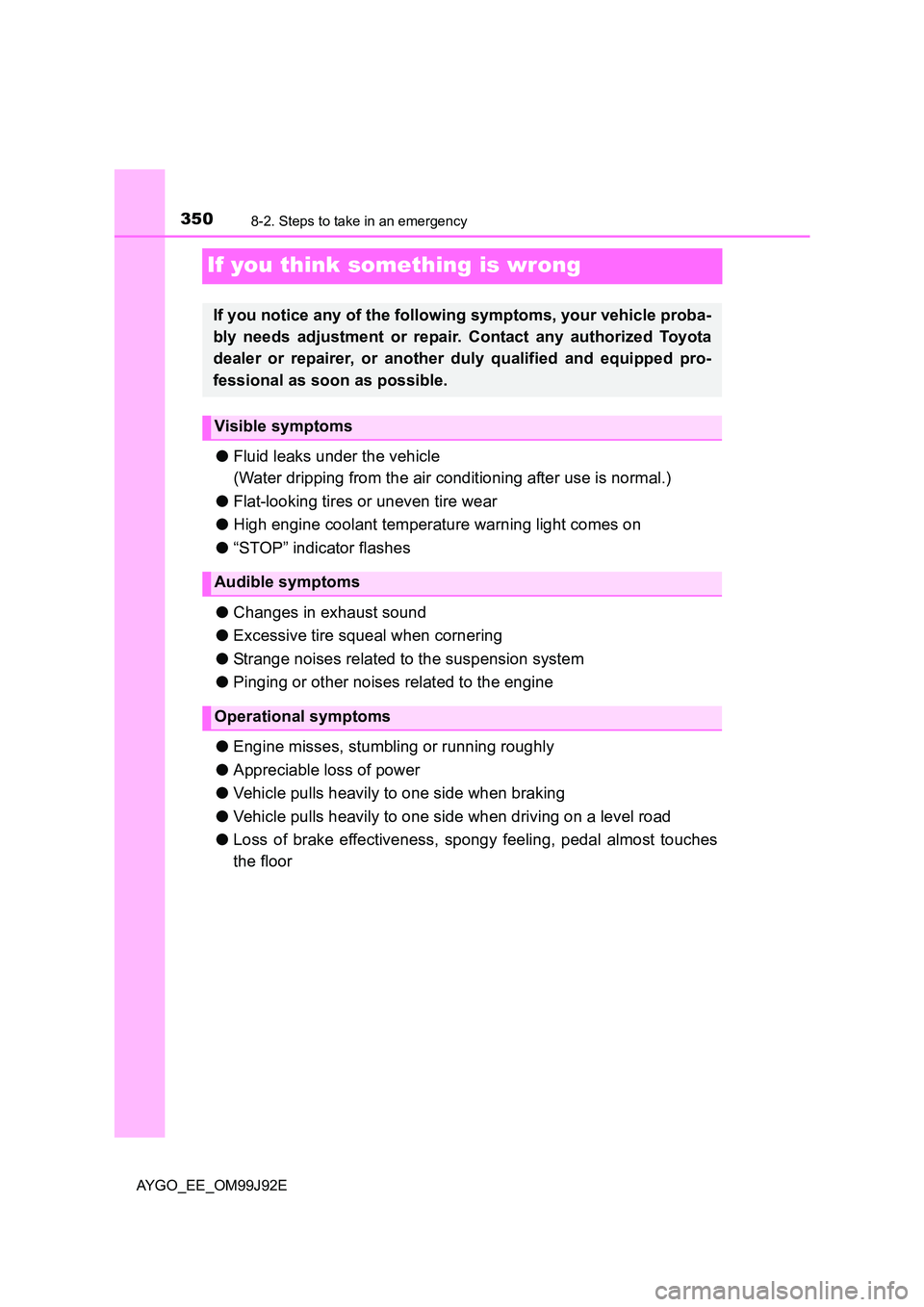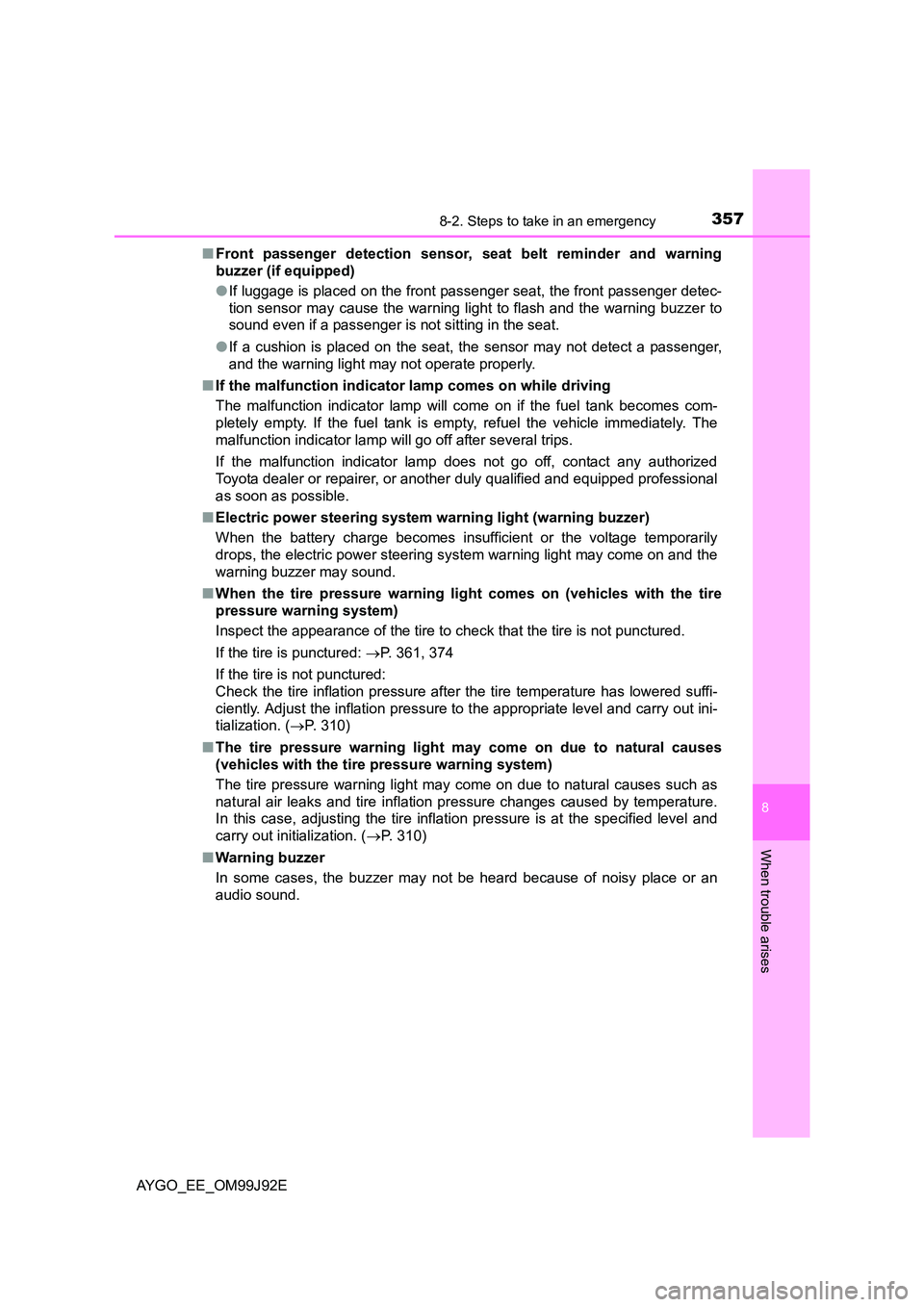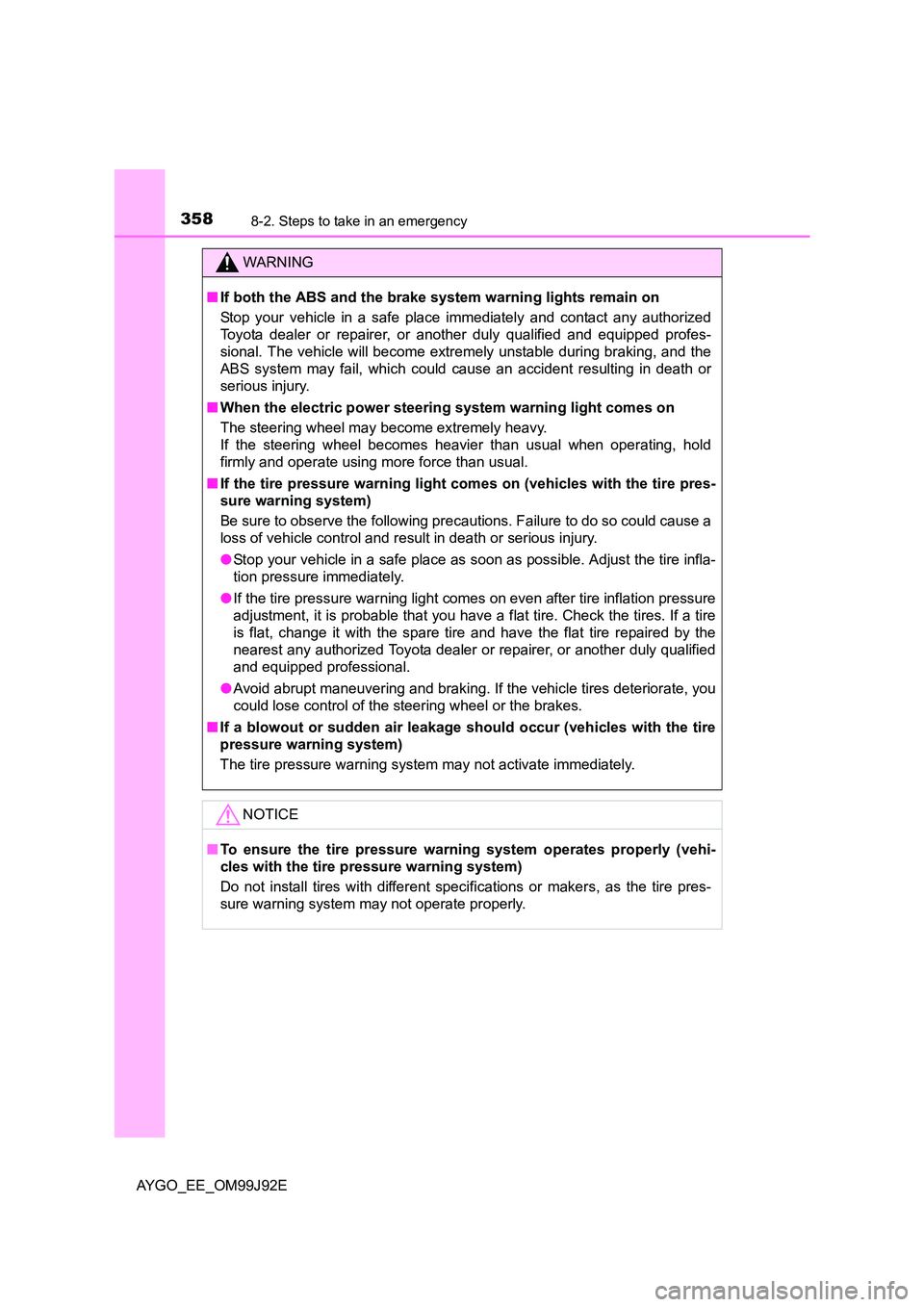Page 341 of 440

341
8When trouble arises
AYGO_EE_OM99J92E
8-1. Essential information
Emergency flashers ........... 342
If your vehicle has to
be stopped in an
emergency ....................... 343
8-2. Steps to take in
an emergency
If your vehicle needs
to be towed ...................... 345
If you think
something is wrong.......... 350
Fuel pump shut off
system ............................ 351
If a warning light turns
on or a warning buzzer
sounds ............................. 352
If you have a flat tire
(vehicles with
a spare tire) ..................... 361
If you have a flat tire
(vehicles without
a spare tire) ..................... 374
If the engine
will not start...................... 388
If the shift lever cannot
be shifted (vehicles
with a multi-mode
manual transmission) ...... 390
If the electronic key does
not operate properly
(vehicles with a smart
entry & start system)........ 391
If the vehicle battery
is discharged ................... 394
If your vehicle overheats .... 398
If the vehicle becomes
stuck ................................ 402
Page 350 of 440

3508-2. Steps to take in an emergency
AYGO_EE_OM99J92E
If you think something is wrong
●Fluid leaks under the vehicle
(Water dripping from the air conditioning after use is normal.)
● Flat-looking tires or uneven tire wear
● High engine coolant temperature warning light comes on
● “STOP” indicator flashes
● Changes in exhaust sound
● Excessive tire squeal when cornering
● Strange noises related to the suspension system
● Pinging or other noises related to the engine
● Engine misses, stumbling or running roughly
● Appreciable loss of power
● Vehicle pulls heavily to one side when braking
● Vehicle pulls heavily to one side when driving on a level road
● Loss of brake effectiveness, spongy feeling, pedal almost touches
the floor
If you notice any of the following symptoms, your vehicle proba-
bly needs adjustment or repair. Contact any authorized Toyota
dealer or repairer, or another duly qualified and equipped pro-
fessional as soon as possible.
Visible symptoms
Audible symptoms
Operational symptoms
Page 356 of 440

3568-2. Steps to take in an emergency
AYGO_EE_OM99J92E
*1: Parking brake engaged warning buzzer:
A buzzer will sound if the vehicle is driven at a speed of approximately
5 km/h (3 mph) or more.
*2: Open door warning buzzer:
A buzzer will sound if the vehicle reaches a speed of 5 km/h (3 mph) or
more with any door open.
*3: Driver’s and passenger’s seat belt buzzer:
The driver’s and passenger’s seat belt buzzer sounds to alert the driver
and passenger that his or her seat belt is not fastened. The buzzer sounds
for 30 seconds after the vehicle reaches a speed of 20 km/h (12 mph).
Then, if the seat belt is still unfastened, the buzzer will sound in a different
tone for 90 more seconds.
*4: Driver’s seat belt reminder light only, on some models
■ To prevent the clutch from overheating (vehicles with a multi-mode man-
ual transmission)
● Do not use the accelerator pedal or starting assist system to hold the vehicle
on a hill.
● On an uphill incline, observe the following whenever possible:
• Maintain a safe distance from the vehicle ahead and avoid unnecessary
starting off and stopping.
• Avoid using E mode on an uphill slope. This will help to avoid unneces-
sary gear changes.
Tire pressure warning light (if equipped)
When the light comes on:
Low tire inflation pressure such as
• Natural causes ( →P. 357)
• Flat tire ( →P. 361, 374)
→ Adjust the tire inflation pressure to the specified level
and carry out initialization.
When the light comes on after blinking for 1 minute:
Malfunction in the tire pressure warning system
→ Have the system checked by any authorized Toyota
dealer or repairer, or another duly qualified and
equipped professional.
Warning lightWarning light/Details/Actions
Page 357 of 440

3578-2. Steps to take in an emergency
8
When trouble arises
AYGO_EE_OM99J92E
■ Front passenger detection sensor, seat belt reminder and warning
buzzer (if equipped)
● If luggage is placed on the front passenger seat, the front passenger detec-
tion sensor may cause the warning light to flash and the warning buzzer to
sound even if a passenger is not sitting in the seat.
● If a cushion is placed on the seat, the sensor may not detect a passenger,
and the warning light may not operate properly.
■ If the malfunction indicator lamp comes on while driving
The malfunction indicator lamp will come on if the fuel tank becomes com-
pletely empty. If the fuel tank is empt y, refuel the vehicle immediately. The
malfunction indicator lamp will go off after several trips.
If the malfunction indicator lamp does not go off, contact any authorized
Toyota dealer or repairer, or another duly qualified and equipped professional
as soon as possible.
■ Electric power steering system warning light (warning buzzer)
When the battery charge becomes insufficient or the voltage temporarily
drops, the electric power steering system warning light may come on and the
warning buzzer may sound.
■ When the tire pressure warning light comes on (vehicles with the tire
pressure warning system)
Inspect the appearance of the tire to check that the tire is not punctured.
If the tire is punctured: →P. 361, 374
If the tire is not punctured:
Check the tire inflation pressure after the tire temperature has lowered suffi-
ciently. Adjust the inflation pressure to the appropriate level and carry out ini-
tialization. ( →P. 310)
■ The tire pressure warning light may come on due to natural causes
(vehicles with the tire pressure warning system)
The tire pressure warning light may come on due to natural causes such as
natural air leaks and tire inflation pressure changes caused by temperature.
In this case, adjusting the tire inflation pressure is at the specified level and
carry out initialization. ( →P. 310)
■ Warning buzzer
In some cases, the buzzer may not be heard because of noisy place or an
audio sound.
Page 358 of 440

3588-2. Steps to take in an emergency
AYGO_EE_OM99J92E
WARNING
■ If both the ABS and the brake system warning lights remain on
Stop your vehicle in a safe place immediately and contact any authorized
Toyota dealer or repairer, or another duly qualified and equipped profes-
sional. The vehicle will become extremely unstable during braking, and the
ABS system may fail, which could cause an accident resulting in death or
serious injury.
■ When the electric power steering system warning light comes on
The steering wheel may become extremely heavy.
If the steering wheel becomes heavier than usual when operating, hold
firmly and operate using more force than usual.
■ If the tire pressure warning light comes on (vehicles with the tire pres-
sure warning system)
Be sure to observe the following precautions. Failure to do so could cause a
loss of vehicle control and result in death or serious injury.
● Stop your vehicle in a safe place as soon as possible. Adjust the tire infla-
tion pressure immediately.
● If the tire pressure warning light comes on even after tire inflation pressure
adjustment, it is probable that you have a flat tire. Check the tires. If a tire
is flat, change it with the spare tire and have the flat tire repaired by the
nearest any authorized Toyota dealer or repairer, or another duly qualified
and equipped professional.
● Avoid abrupt maneuvering and braking. If the vehicle tires deteriorate, you
could lose control of the steering wheel or the brakes.
■ If a blowout or sudden air leakage should occur (vehicles with the tire
pressure warning system)
The tire pressure warning system may not activate immediately.
NOTICE
■ To ensure the tire pressure warning system operates properly (vehi-
cles with the tire pressure warning system)
Do not install tires with different specifications or makers, as the tire pres-
sure warning system may not operate properly.
Page 361 of 440
3618-2. Steps to take in an emergency
8
When trouble arises
AYGO_EE_OM99J92E
If you have a flat tire (vehicles with a spare
tire)
● Stop the vehicle on a hard, flat surface.
● Set the parking brake.
● Shift the shift lever to M, E or R (vehicles with a multi-mode manual
transmission) or R (vehicles with a manual transmission).
● Stop the engine.
● Turn on the emergency flashers. (→P. 342)
Your vehicle is equipped with a spare tire. The flat tire can be
replaced with the spare tire.
For details about tires: →P. 3 0 8
WARNING
■ If you have a flat tire
Do not continue driving with a flat tire.
Driving even a short distance with a flat tire can damage the tire and the
wheel beyond repair, which could result in an accident.
Before jacking up the vehicle
Page 363 of 440

3638-2. Steps to take in an emergency
8
When trouble arises
AYGO_EE_OM99J92E
WARNING
■ Using the tire jack
Observe the following precautions.
Improper use of the tire jack may cause the vehicle to suddenly fall off the
jack, leading to death or serious injury.
● Do not use the tire jack for any purpose other than replacing tires or install-
ing and removing tire chains.
● Only use the tire jack that comes with this vehicle for replacing a flat tire.
Do not use it on other vehicles, and do not use other tire jacks for replac-
ing tires on this vehicle.
● Put the jack properly in its jack point.
● Do not put any part of your body under the vehicle while it is supported by
the jack.
● Do not start the engine or drive the vehicle while the vehicle is supported
by the jack.
● Do not raise the vehicle while someone is inside.
● When raising the vehicle, do not put an object on or under the jack.
● Do not raise the vehicle to a height greater than that required to replace
the tire.
● Use a jack stand if it is necessary to get under the vehicle.
● Stop the vehicle on firm, flat and level ground, firmly set the parking brake
and shift the shift lever to M, E or R (vehicles with a multi-mode manual
transmission) or R (vehicles with a manual transmission). Block the wheel
diagonally opposite to the one being changed if necessary.
● When lowering the vehicle, make sure that there is no-one near the vehi-
cle. If there are people nearby, warn them vocally before lowering.
Page 366 of 440
3668-2. Steps to take in an emergency
AYGO_EE_OM99J92E
Chock the tires.
Remove the wheel ornament using the wrench.
To protect the wheel ornament, place a rag between the wrench and the
wheel ornament as shown in the illustration.
Replacing a flat tire
1
Flat tireWheel chock positions
FrontLeft-hand sideBehind the rear right-hand side tire
Right-hand sideBehind the rear left-hand side tire
RearLeft-hand sideIn front of the front right-hand side tire
Right-hand sideIn front of the front left-hand side tire
2
�XVehicles with full wheel orna-
ment
�XVehicles with center ornament